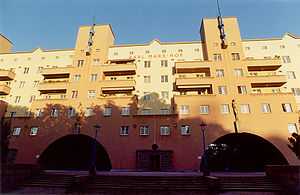Karl Marx-Hof


Karl Marx-Hof (English: Karl Marx Court) is one of the best-known Gemeindebauten (English: municipal tenement complexes) in Vienna, situated in Heiligenstadt, a neighbourhood of the 19th district of Vienna, Döbling.
Development
Karl Marx-Hof is built on land that, until the 12th century, had been under the waters of the Danube, deep enough for ships to travel over the area. By 1750, all that remained was a pool of water, which was drained on the order of Holy Roman Emperor Joseph II. Gardens were then built in the area, but these were removed by the Vienna city council, then controlled by the Social Democratic Party of Austria, to make room for the erection of Karl Marx-Hof, financed by a special tax named after councillor Hugo Breitner, commissioning locally and internationally renowned architects.
Karl Marx-Hof was built between 1927 and 1930 by city planner Karl Ehn, a follower of Otto Wagner. It held 1,382 apartments (with a size of 30–60 m² each) and was called the Ringstraße des Proletariats, the Ring-road of the Proletariat. (Vienna's principal Ringstraße, dating from the 1850s, surrounds the city centre and had been intended as a showcase for the grandeur and glory of the Habsburg Empire). Only 18.5% of the 1,000 metres long, 156,000-m² large area was built up, with the rest of the area developed into play areas and gardens. Designed for a population of about 5,000, the premises include many amenities, including laundromats, baths, kindergartens, a library, doctor offices, and business offices.
Austrian Civil War, Austrofascism, and the Anschluss
Karl Marx-Hof was well known during the Februaraufstand (German: February Uprising) of the 1934 Österreichischer Bürgerkrieg (German: Austrian Civil War). Those engaged in the revolt barricaded themselves inside the building and were forced to surrender after the Austrian army, the police, and the Austrofascist paramilitary Heimwehr bombarded the site regardless of the unarmed dwellers, mainly worker families, with artillery.[1] During the Anschluss, Karl Marx-Hof was renamed Heiligenstädter Hof, but took its original name back in 1945.
Today
The heavy artillery damage to Karl Marx-Hof was repaired in the 1950s. It has been used as a filming location for some movies, most notably The Night Porter. The building was refurbished between 1989 and 1992. At over one kilometre in length (1100m, 0.68 mile) and spanning four Straßenbahn (tram) stops, Karl Marx-Hof holds the distinction of being the longest single residential building in the world.
See also
| Wikimedia Commons has media related to Karl-Marx-Hof. |
Other very long housing blocks
- Byker Wall, Newcastle upon Tyne, UK
- Park Hill, Sheffield, UK
- Falowiec, Gdansk, Poland
References
External links
Coordinates: 48°15′10″N 16°21′54″E / 48.25278°N 16.36500°E